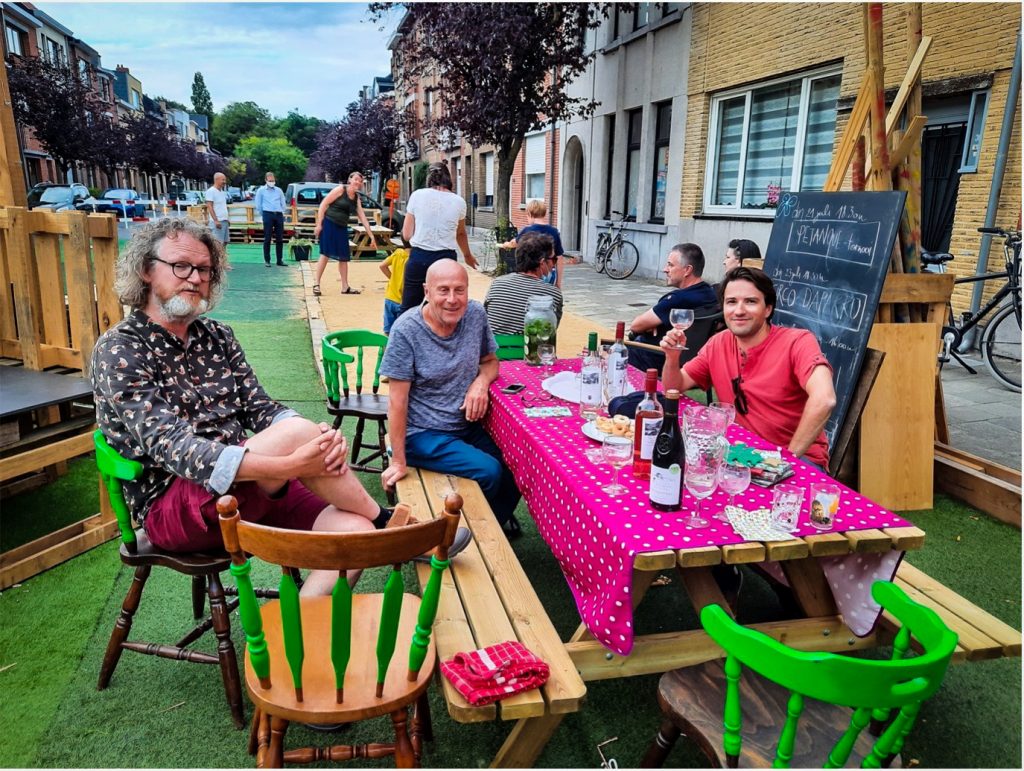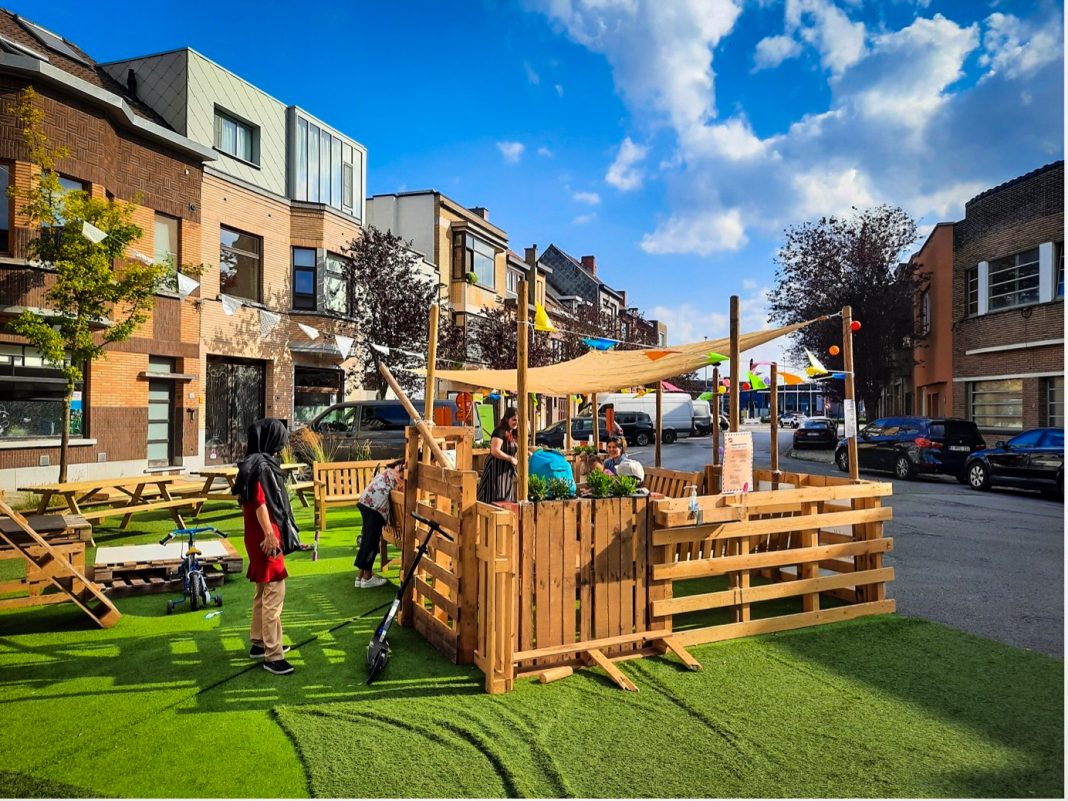In the last decade, Ghent has completely revived its urban landscape into a place for people to thrive. Through spatial planning, tactical urbanism, and improved cycling and walking infrastructure, this Belgian city has become a leader for car-free developments in Europe. We took a look into one of Ghent’s most successful projects — ‘Living Streets’ — to find out how neighbourhoods are being transformed on a local level, and what you can do to make your city’s streets come alive too…
Ghent’s Journey to Green:
The centre of Ghent has been almost ‘car-free’ since 1997 when the council decided to pedestrianize 35 acres of the inner city to counter extreme traffic and congestion build-up.
However, in the last decade the transformation has continued on such a large scale that the city’s goal to achieve a cycling modal share of 35% by 2030 was met in 2019, 11 years earlier than predicted. The transformation was achieved through several different measures, but one of the biggest changes was the ‘Circulation Plan’ that Ghent introduced in 2017 which completely changed people’s mobility patterns within the city.
Around the main inner-city car-free zone, six new pedestrian districts were created so that the cars which used to drive between these designated areas now have to use the ring road on the outskirts to travel between them instead.
The Living Streets project also played a huge part in the city’s transformation on a neighbourhood level, which has helped to counter resident’s opposition to the car-lite changes happening around the city. We spoke to Sofie Rottiers and Hanne Geutjens from Team Leefstraten (Living Streets) at Stadt Ghent to find out more about the project and what CityChangers around the world can learn from it.
What Is a Living Street?
A living street is a road that is partially or completely closed off to auto traffic to be used for alternative purposes, and normally occurs for a two-month period over summer. It began as an experiment involving only two streets almost 8 years ago but now extends to over 25 residential roads across the city.
A road can be transformed into a living street in several ways – it can be turned into a playground for children, a place to have street parties with barbecues and pop-up cafes, cosy meet-up and living spaces, allotments, flower beds, and street furniture for places to stop and rest.

The idea for the experiment was developed by the Trojan Lab to help residents’ visions come to life — an independent network of collaborating citizens, civil servants, and other groups in the municipality of Ghent.
The design of a living street is left entirely up to the residents who live there – nothing is mandatory, so people are free to think up new and inventive ways to use the space. They are encouraged to work together and collaborate to figure out what will work best. The city council also plays a huge role in supporting the process of creating living streets by ensuring the necessary permits and licences are in place, and that all the necessary materials are available.
“The idea was really just to see how it goes — we wanted to see how we could get cars to park elsewhere, how we could recreate the streets and reconnect the people who live there”, Sofie says. But living streets are about so much more than just ‘removing cars’, they also serve to benefit the city and its people in an abundance of other ways.
From a social perspective, people get to know one another, neighbours have a reason to connect, cohesion is strengthened, solidarity increases and residents who don’t have a garden are able to enjoy a communal outdoor space. Likewise, taboo topics like poverty, mobility, and gentrification become part of the conversation and are actually talked about.
Participants in the project said that “experimentation is a huge opportunity to strengthen a neighbourhood’s social contacts – during the process almost all residents get in touch with each other when they use their streets as parks and build relationships.”
How Do You Create a Living Street?
We asked Sofie and Hanne what their ‘top tips’ are for creating living streets in other cities, and what key things CityChangers should keep in mind when trying to replicate a similar project:
1. By the people, for the people
One of the key aspects of living streets is allowing people to do most of the planning and decision-making themselves, Hanne says. “We try to make the process as democratic as possible – we ask the people setting up the living street to go to every house and ask what their ‘dream street space’ would look like, and what things they want to change.”
But Hanne says that residents should also try to have an open conversation about their fears and concerns regarding living streets: “You also need to ask neighbours what is holding them back from repurposing their street, so then you can address their worries and help to overcome them.”
“It is really a bottom-up project. Once all the information is gathered, the people get to decide how the living street will look and how long it will last for. The proposal then comes to us at the social department and we check for an official permit so that residents are able to implement their plans.”
2. Don’t ask for signatures only
Another point to add to the previous tip is that signatures on a piece of paper aren’t the only thing you need to create living streets. ‘We don’t ask people for signatures. The most important thing is really talking to everyone’, Sofie and Hanne said.
“That way people really have to look for solutions to the problems themselves before living streets are implemented – never only rely on signatures because this doesn’t give people the chance to properly understand what a living street is and how it will affect their neighbourhood.”
If you want to get people on board with your proposal, then go door-to-door to explain to people what it is you want to achieve, and deal with their concerns on an individual basis.
3. Get council support
Sofie and Hanne said that perhaps what has allowed the Living Streets project to be so successful is that the Ghent city council does so much to support it.
“In other cities, people have to put together petitions and political campaigns to get the support of their local authorities — but in Ghent, we already have the existing resources to support the creation of living streets. Everything from finances and licences to street furniture is provided by us.”
As an individual, you could try to get your local council or authority to set aside a fund for events like these to take place in your city. If you already have direct influence over council decisions, then try to push for the importance of having the resources already in place for projects like Living Streets to be able to come to life.

4. Deal with opposition
We also asked Sofie and Hanne how they dealt with opposition from car-drivers and opponents to living streets.
“We try to solve issues relating to mobility on a 1-to-1 basis. For example, if for on neighbour it is essential that they park right outside of their house, then of course, we allow them to do that.”
“We try to make the focus less about mobility and more about social cohesion, and deal with the problems incrementally as they come’, said Hanne. ‘If we need 10 parking spaces to build a nice parklet, then we will individually ask 10 neighbours to park outside of the street. This way the impact stays relatively low, but we can still achieve our goals.”
Living Streets In a Nutshell
Ghent’s mobility transformation is a story of great success and living streets in particular show just how far the city has come in its journey to becoming more socially inclusive and sustainable.
Living streets are a local / neighbourhood level project, which means that you don’t need to have a seat on your local council to be able to get the ball rolling. Take a look at our article on how to create a car-free pop zone in your city for more detailed information about closing off a road to cars.
Also, check out how many other cities have already gotten inspired by Ghent’s example here, and join the Living Street community here.



[…] Initially, only two roads were chosen as “living streets”, but now it has been expanded to 25. City Changers writes. […]